- YieldMax Ultra Option Income Strategy ETF is recommended with a hold rating due to its income generation and high correlation with the NASDAQ Index.
- ULTY employs an actively managed covered options strategy across various tech sector equities, providing diversified exposure and potential income stability.
- Despite a high expense ratio of 1.24%, ULTY's forward distribution rate of 84.43% significantly outpaces QQQ's yield, justifying its cost for passive income seekers.
- Given potential NASDAQ weakness and ULTY's high correlation, downside risk exists but may be mitigated by the income component, warranting a cautious hold rating.

ilkercelik/E+ via Getty Images
YieldMax Ultra Option Income Strategy ETF (NYSEARCA:ULTY) is an actively managed options strategy with the intent of providing passive investors income. The mechanism for generating income for investors is primarily driven by the underwriting of options strategies across an array of companies, unlike YieldMax's single-name stock strategies. Given the performance of the strategy in terms of income generation and its share performance relative to the NASDAQ (QQQ) Index, I recommend ULTY with a hold rating.
How The Strategy Works
ULTY's primary purpose is to generate income for investors in the ETF strategy. This is an actively managed portfolio strategy that manages a book of options and equities that primarily reside in the tech sector. Unlike YieldMax's single-name options strategies like AMDY (AMDY) or CONY (CONY), ULTY actively manages a covered options strategy across a variety of tickers as well as direct ownership in equities. This provides investors with a more diversified strategy and can potentially offer more relative stability when compared to a pure options strategy on a single-name stock. Despite these factors, ULTY is significantly correlated with the NASDAQ Index and is relatively directionally driven, net of distributions.
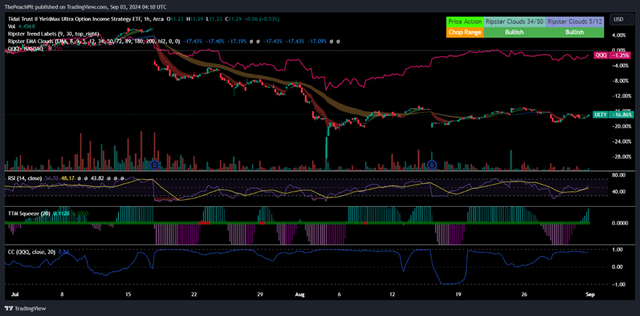
TradingView
Given this relationship plus the income factor, I have reason to believe that ULTY can offer investors in the tech sector a more concentrated exposure with the included income component. The forward distribution rate was recently reported at 84.43%, significantly higher than QQQ's forward yield of 56bps.
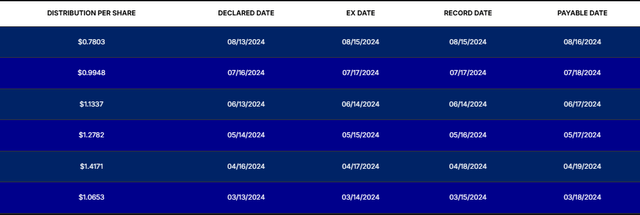
Corporate Reports
ULTY's dividend rate has varied significantly since inception. Given that the ETF was launched on February 28, 2024, the distribution history may not be a strong indicator for future payouts. It is worth noting that the monthly distribution rate has declined just about every month since inception. Though this appears to be a trend, I believe it is too early in the fund's life to determine if the declining distribution rate will persist.
One major factor that comes into play is that ULTY comes with a significantly higher fee when compared to its other strategies or passive ETFs. ULTY commands a 1.24% gross expense ratio. This compares to Invesco's QQQ ETF of 20bps. Despite this factor, the distribution rate far outpaces the elevated management cost, making this strategy a strong candidate for passive income while attaining similar exposure to the NASDAQ Index. CONY and AMDY each have gross expense ratios of 99bps while offering a similar distribution rate.
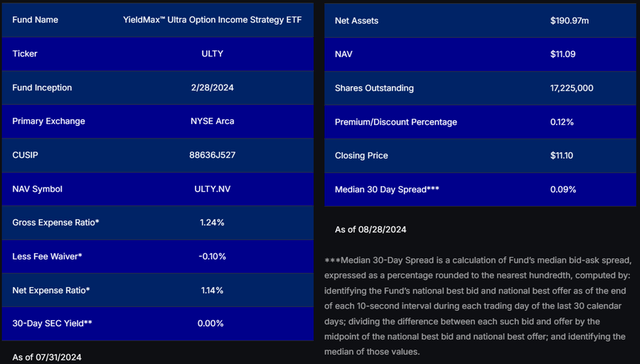
Corporate Reports
Looking at the portfolio assets, the top holdings are in equities and include MicroStrategy (MSTR) at 8.47%, Nvidia (NVDA) at 7.77%, Upstart Holdings (UPST) at 6.93%, and Direxion Daily S&P Biotech Bull 3X (LABU) at 6.49%. The top options strategies are short call options and include Samsara Inc. (IOT) at -0.27%, Summit Therapeutics (SMMT) at -0.25%, C3.ai (AI) at -0.23%, and Broadcom (AVGO) at -0.21%.
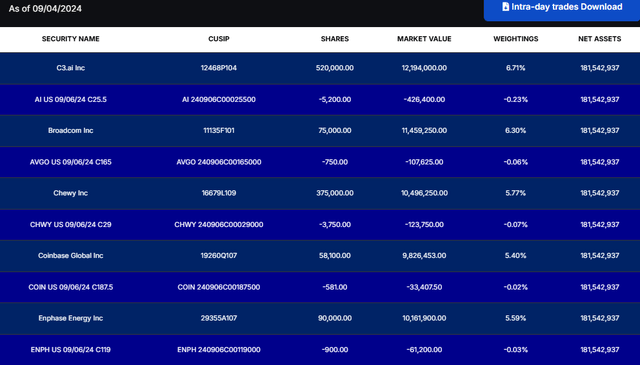
Corporate Reports
The covered call strategy may suggest that the portfolio strategy is relatively bearish on the holdings given the short-long exposure. Unlike the synthetic covered-options strategy as seen in the single-name stock ETFs YieldMax manages, the covered-options strategy may create a limiting factor on the portfolio's overall growth and may be one of the driving factors towards its correlation with the NASDAQ Index.
Though I'm not one to forecast the aggregate index, I have reason to believe that there may be some weakness in the NASDAQ in the coming quarters given the post-earnings performance across some of the larger names, including Nvidia, Microsoft, Amazon (AMZN), and Google (GOOG). Though some of the downside risk can be attributed to the unwinding of the JPY carry trade, I believe analysts and traders will more heavily scrutinize growth and profitability on a more incremental basis as investors become more risk-averse.
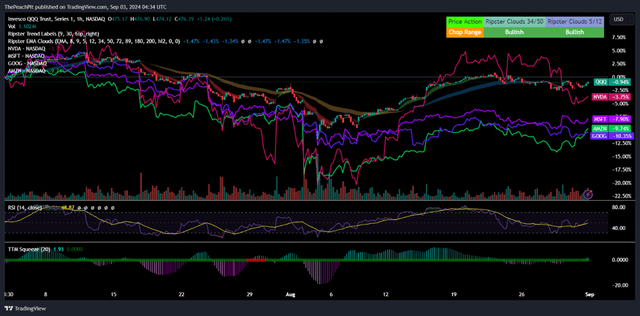
TradingView
Conclusion
ULTY offers a significant amount of value to an investor seeking exposure to the tech sector tied to the income component. This strategy is derived from a covered call portfolio where it currently stands and offers investors income through its options underwriting strategy. Given the overall sentiment towards the tech sector and ULTY's high correlation to the NASDAQ Index, I believe there may be some downside risk to the underlying equity strategy that may be offset by the income component. For this reason, I recommend ULTY with a hold rating.
Comments